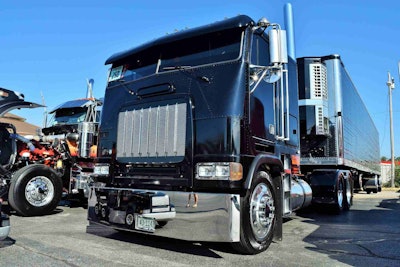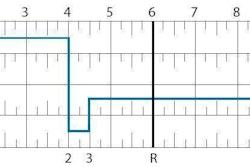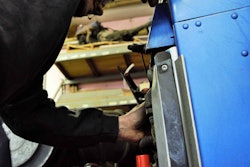
Owner-operator Randy Carlson of Minnesota hadn’t heard the recent news of the Federal Motor Carrier Safety Administration’s policy reversal of sorts when it comes to just how the feds envisioned roadside enforcement would determine whether a truck was exempted from the electronic logging device mandate by its model year or not. I hadn’t heard it either but for the initial story in Overdrive last week as I was out on a little R&R, as it were. Back at the desk today, however, I thought of Carlson first and foremost. Back late last year, when I first talked to him, he was mulling a variety of potential moves for his unique situation, which I wrote about at the time.
Carlson has plenty mechanicking in his past, and decades around trucking, much of the time as an owner-operator doing the majority of his own work on the truck. It’s a 2001 Freightliner Classic chassis powered by an older, fully mechanical Caterpillar engine. With the pre-2000 model year exemption tied exclusively to the model year of the truck, he’d have been required to invest in an ELD workaround to keep that truck in compliance, or back-fit his finely-tuned mechanical engine within a pre-2000 cab/chassis, to keep running it legally after the mandate.

When he heard in my email and voice messages today that FMCSA was now prepared to direct enforcers to default to the engine model year for exemption determinations in situations where truck and engine model years differed, “Sounds like it’s a good day for me,” he said.
A good day for a lot of glider owners, too.
FMCSA spokesman Duane DeBruyne confirmed the change in guidance on the exemption and noted the agency’s rationale centered around costs of retrofitting solutions for situations at least somewhat like Carlson’s, glider-type situations where the truck is of a considerably newer model-year vintage than the engine. “The original intent of the provision was to address the fact that pre-2000 model year trucks may not allow an electronic logging device to easily and inexpensively connect to the engine,” he wrote in response to Overdrive News Editor James Jaillet’s queries about the situation. “While the Agency has confirmed that there are ways of equipping pre-2000 model year vehicles to use an ELD consistent with the rule’s technical specifications, these are typically neither cost-beneficial nor practical” for owners, as we’ve reported in past.
At once, there’s been a cost for Carlson to the indecision the Agency has shown on the exemption, particularly with this recent move after so long (a full year and a half) holding to the line in the rule that the truck’s model year would be the defining factor in determining the exemption. In Spring this year, Carlson located a 1996 Freightliner powered by a same-year Detroit Series 60 that had been “an old Crete truck,” he says. He paid $4,500 for it, then another couple thousand over the subsequent months toward getting it in some working order.
“I was going to maybe drive that one,” he adds, in the interim until he could find a pre-2000 cab/title to go with his mechanical Caterpillar engine. “I’m probably not going to do that now” in spite of the near $7,000 investment he’s already made in the 1996 unit. He was “just working on it last weekend, buffing it up after being faded from sitting around” for 10 years unused. He “fixed the door on it the week before,” all in preparation to get it “ready to drive.” It wasn’t there yet, though. “I figured I would have had about $12-$13,000 in it to get it ready to go down the road.”
He can rest a little easier now, he says, but not so anyone out there who “had a 1999 truck who bought a 2003-’04” engine to put in, Carlson says. Anybody in that spot now? As for the new guidance — not capital-G “Guidance,” as it were, but pretty much all there is for official word on this subject thus far, DeBruyne notes — “the FAQ is it” in terms of the guiding policy on this subject at this point, DeBruyne says.
In the Trump era, when governing by Tweet is something of a norm, “regulating by FAQ” might stand to gain in prominence, I suppose.
Drivers taking the exemption by virtue of the model year of their engine would do well to carry documentation of the engine year if it’s not visibly, clearly stamped somewhere on the engine itself, a notion DeBruyne says he concurs with. Without an obvious model-year/date-of-manufacture stamp visible on his mechanical Cat, owner-operator Carlson notes he’s likely to get a print-out from the engine maker to carry, given his 2001 year truck.
Carlson adds he ran across a private party in Missouri selling a 1997 or ’98 model-year “Freightliner Classic extended hood like mine (a 2001),” the for-sale rig powered by “a newer Detroit in the 2003-’05 range. If anybody’s done that” thinking they’d avoid the ELD mandate, “they’re not going to be happy campers.” Under the new policy, the need to use an ELD or not would follow the engine model year, not the truck’s, and they’d need to run electronic.










